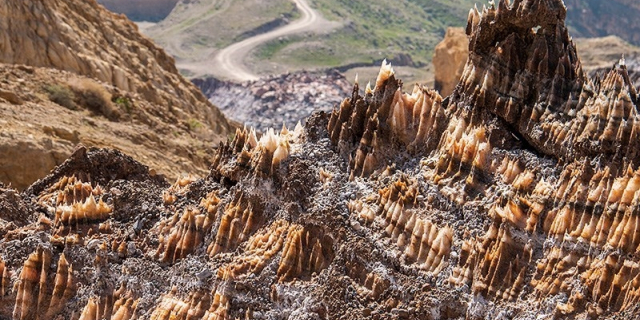Al-Aḥsāʾ (Arabic: الْأَحْسَاء, al-ʾAhsā), also known as al-Ḥasāʾ (الْحَسَاء) or Hajar (هَجَر), is an oasis and historical region in eastern Saudi Arabia. Al-Ahsa Governorate, which makes up much of the country's Eastern Province, is named after it. The oasis is located about 60 km (37 mi) inland from the coast of the Persian Gulf. Al-Ahsa Oasis comprises four main cities and 22 villages. The cities include Al-Mubarraz and Al-Hofuf, two of the largest cities in Saudi Arabia.
 Jawatha Mosque in Al-AhsaAncient history
Jawatha Mosque in Al-AhsaAncient history
Al-Ahsa has been inhabited since prehistoric times because of its abundance of water in an otherwise arid region.[1] Natural fresh-water springs have surfaced at oases in the region for millennia, encouraging human habitation and agricultural efforts (date palm cultivation especially) since prehistoric times.[2]
The oasis region and specifically the name Hajar (also Hagar, Haǧar) may be related to the Ancient Near East toponym Agarum, mentioned in Dilmunite inscriptions as the original home of their chief deity Inzak. If so, Agarum probably referred to the mainland area of Arabia lying opposite Bahrain.[3] According to the hypothesis, the Dilmun civilization originated at the oases of Eastern Arabia, but later relocated to the isle of Bahrain. This interpretation is not without criticism, however, and other sources place Agarum on the isle of Failaka.[4]
Islamic timesEastern Arabia was conquered by the emerging Rashidun Caliphate during the 7th century. It was later inherited by the Umayyads and Abbasids. In 899 the region came under the control of the Qarmatian leader Abu Tahir al-Jannabi[5] and was declared independent from the Abbasid Caliphate of Baghdad. Its capital was at al-Mu'miniya near modern Hofuf. By circa 1000, Al-Ahsa became the ninth largest city worldwide supporting 100,000 inhabitants.[6] In 1077, the Qarmatian state of Al-Ahsa was overthrown by the Uyunids. Al-Ahsa subsequently fell under the rule of the Bahrani dynasty of the Usfurids, followed by their relatives, the Jabrids, who became one of the most formidable powers in the region, retaking the islands of Bahrain from the princes of Hormuz. The last Jabrid ruler of Bahrain was Muqrin ibn Zamil.[citation needed]
In 1521, the Portuguese Empire conquered the Awal Islands (the islands that comprise present day Bahrain) from the Jabrid ruler Muqrin ibn Zamil.[7] The Jabrids struggled to maintain their position on the mainland in the face of the Ottomans and their tribal allies, the Muntafiq. In 1550, Al-Ahsa and nearby Qatif came under the sovereignty of the Ottoman Empire with Sultan Suleiman I.[8] Al-Ahsa was nominally the Eyalet of Lahsa in the Ottoman administrative system and was usually a vassal of the Sublime Porte. Qatif was later lost to the Portuguese.[9] The Ottomans were expelled from Al-Ahsa in 1670,[8] and the region came under the Banu Khalid Emirate.
Al-Ahsa, along with Qatif, was incorporated into the Wahhabist Emirate of Diriyah in 1795 but returned to Ottoman control in 1818 with an invasion ordered by Muhammad Ali of Egypt. The Banu Khalid were again installed as rulers of the region but, in 1830 the Emirate of Nejd retook the region.[10]
Direct Ottoman rule was restored in 1871,[8] and Al-Ahsa was placed first under Baghdad Vilayet and with Baghdad's subdivision Basra Vilayet in 1875. In 1913, ibn Saud, the founder of modern Saudi Arabia, annexed Al-Ahsa and Qatif into his domain of Najd.[11]
Saudi independenceOn 2 December 1922, Percy Cox officially notified Kuwait's Emir Sheikh Ahmad Al-Sabah that Kuwait's borders had been modified.[12] Earlier that year, Major John More, the British representative in Kuwait, had met with Ibn Saud to settle the border issue between Kuwait and Najd. The result of the meeting was the Uqair Protocol of 1922, in which Britain recognized ibn Saud's sovereignty over territories claimed by the emir of Kuwait. Al-Ahsa was taken from the Ottomans in 1913,[13] bringing the Al Sauds control of the Persian Gulf coast and what would become Saudi Arabia's vast oil reserves.[citation needed]
































Add new comment